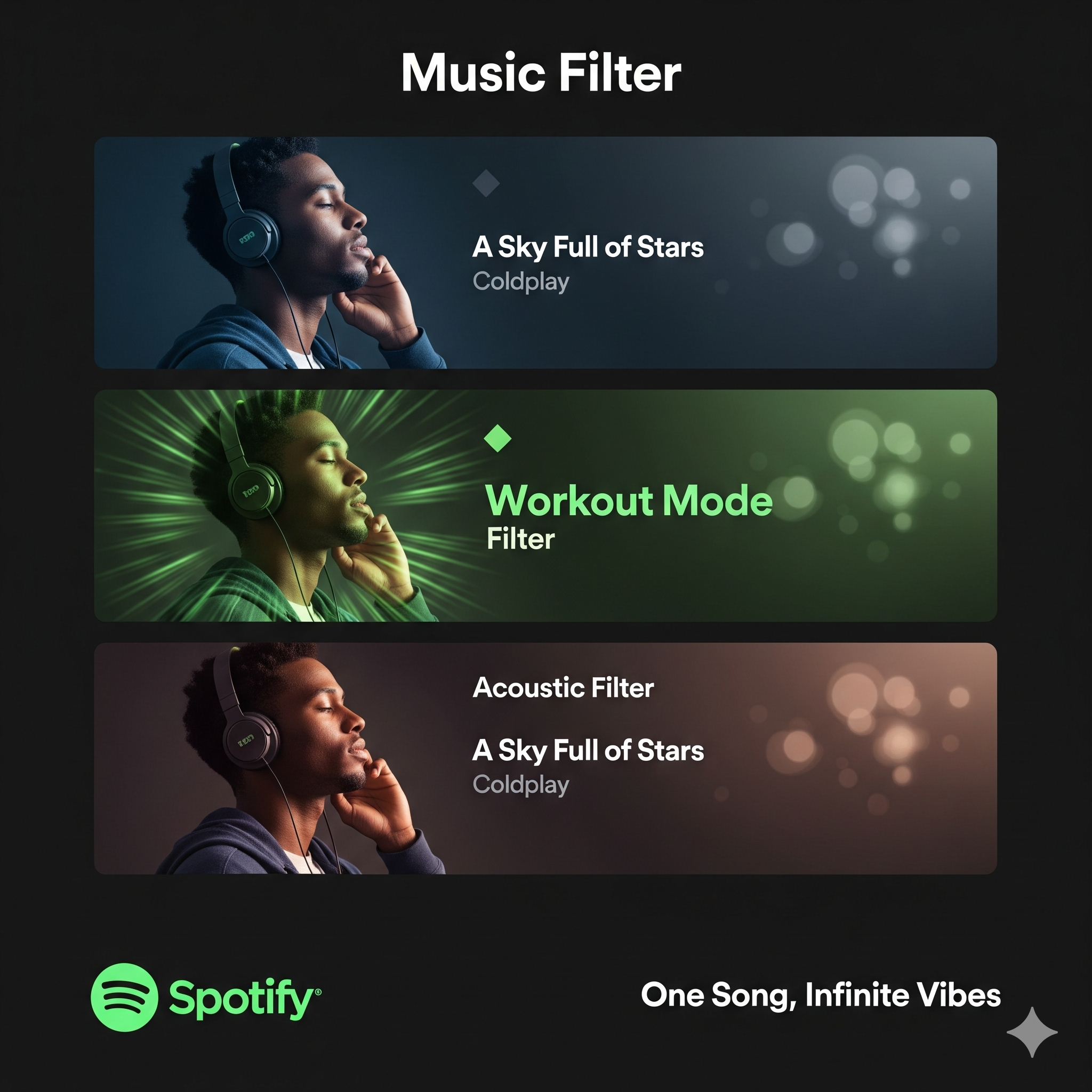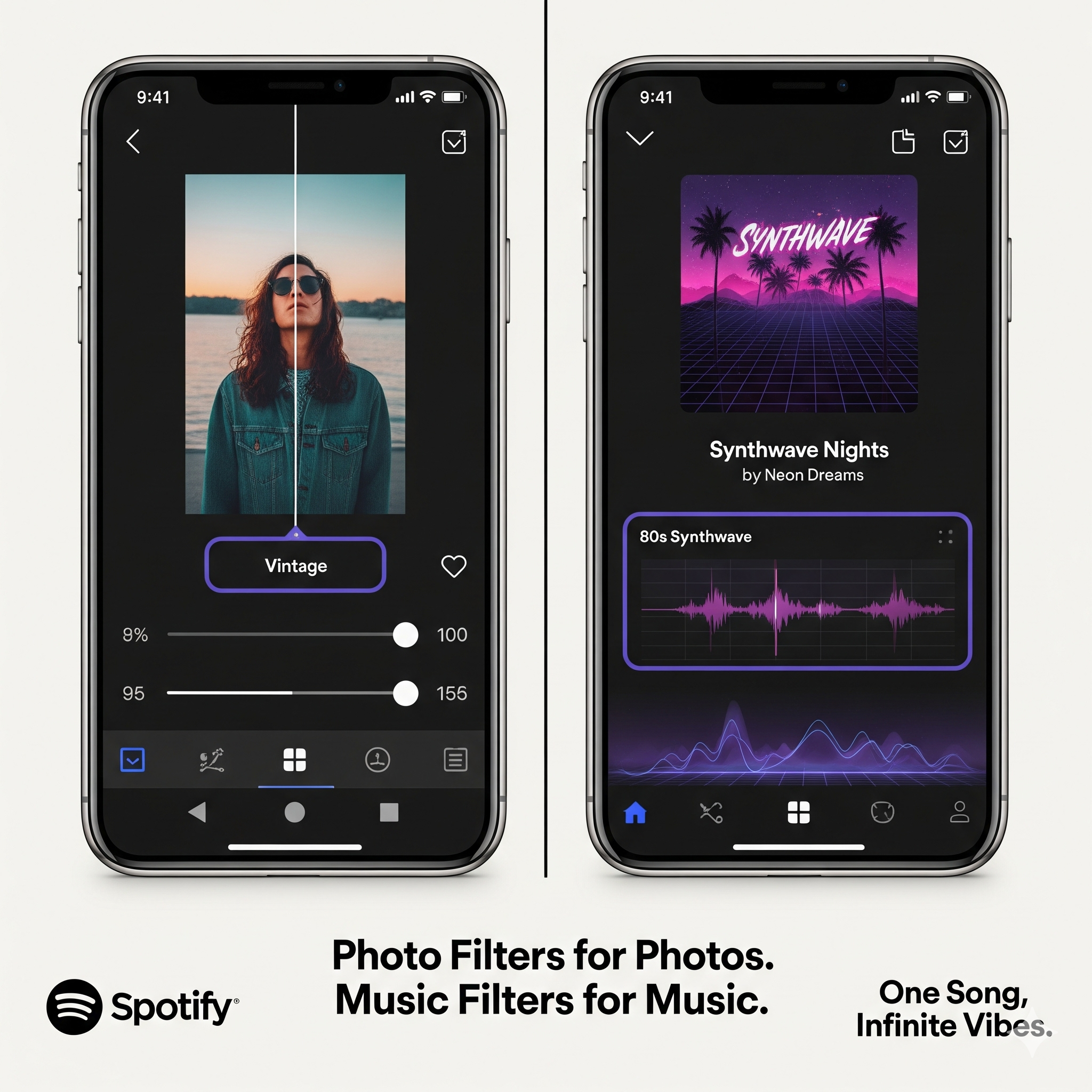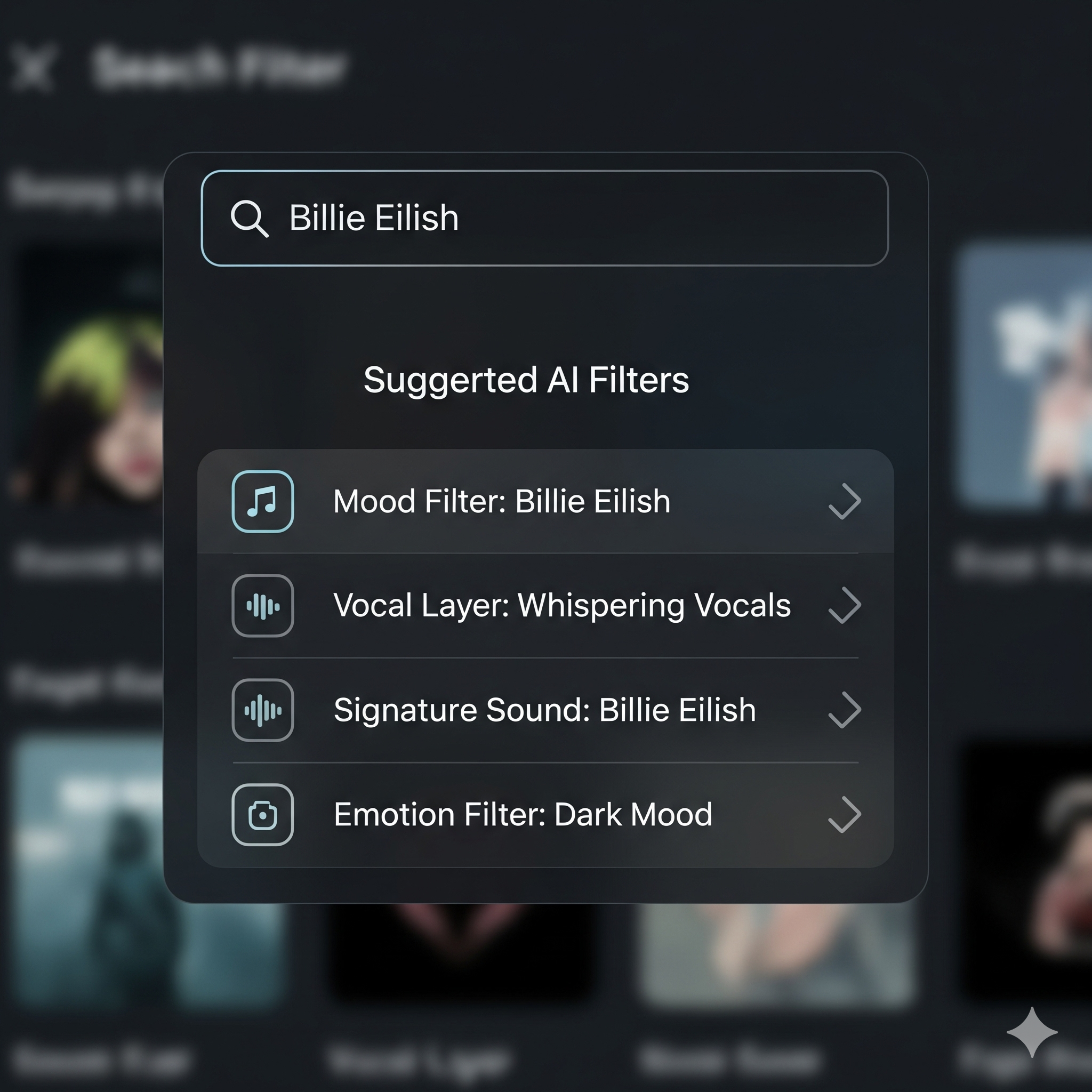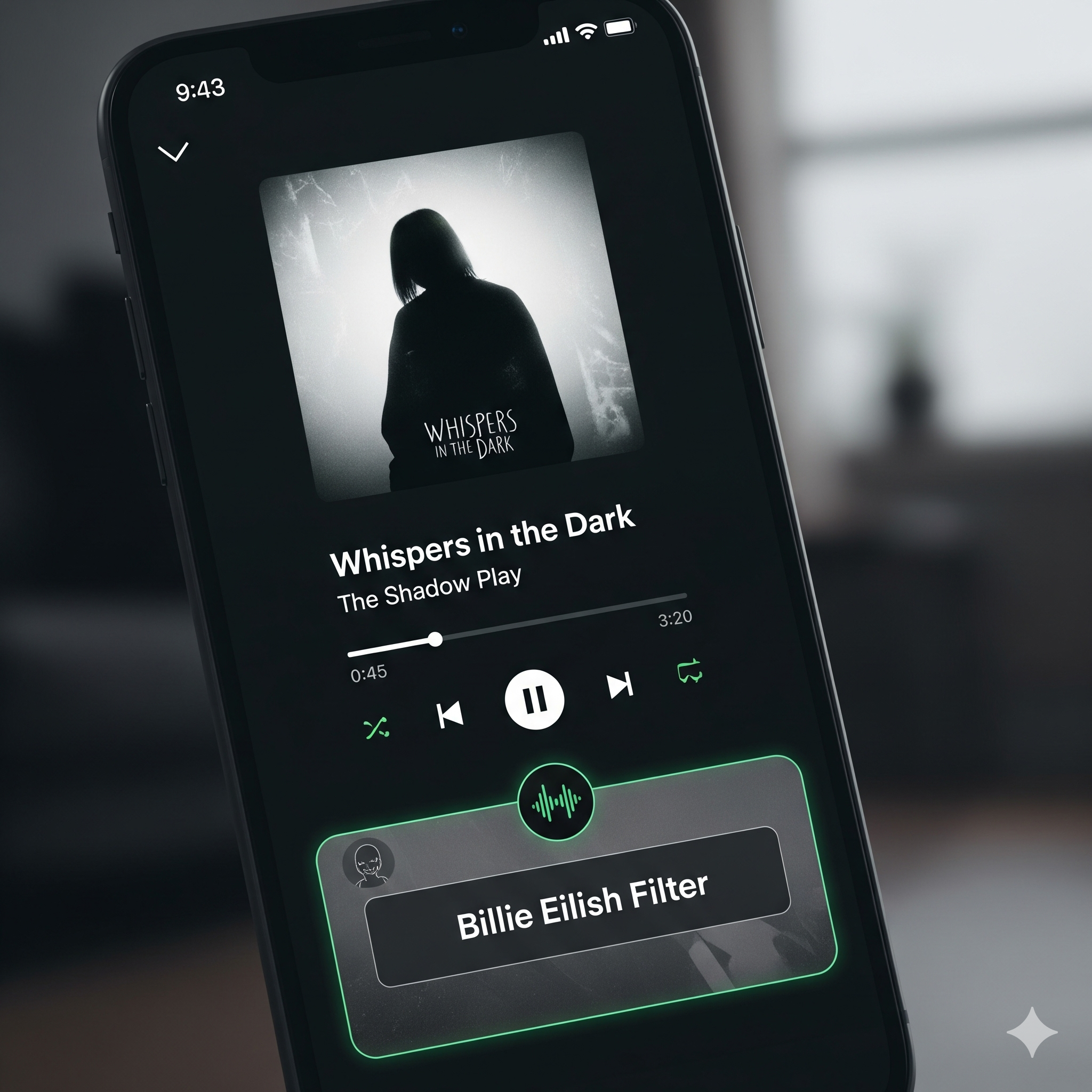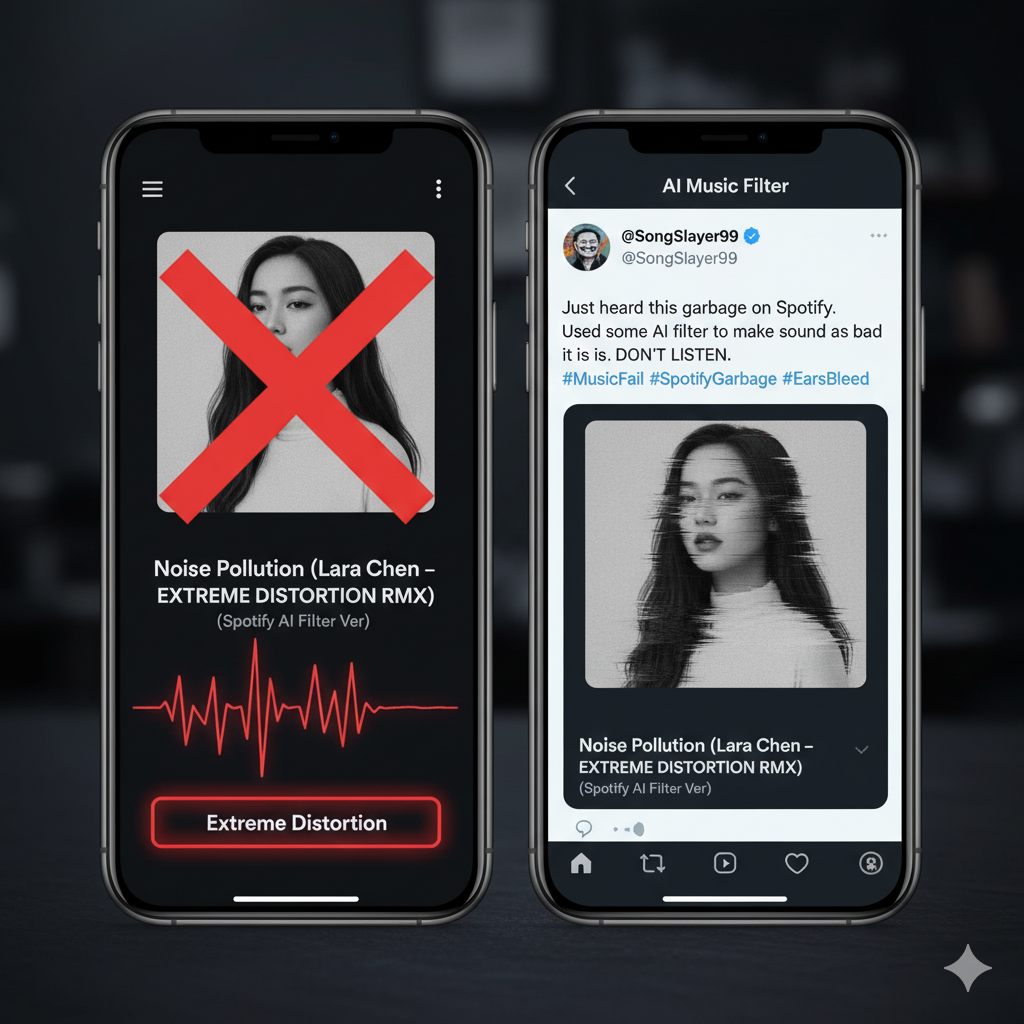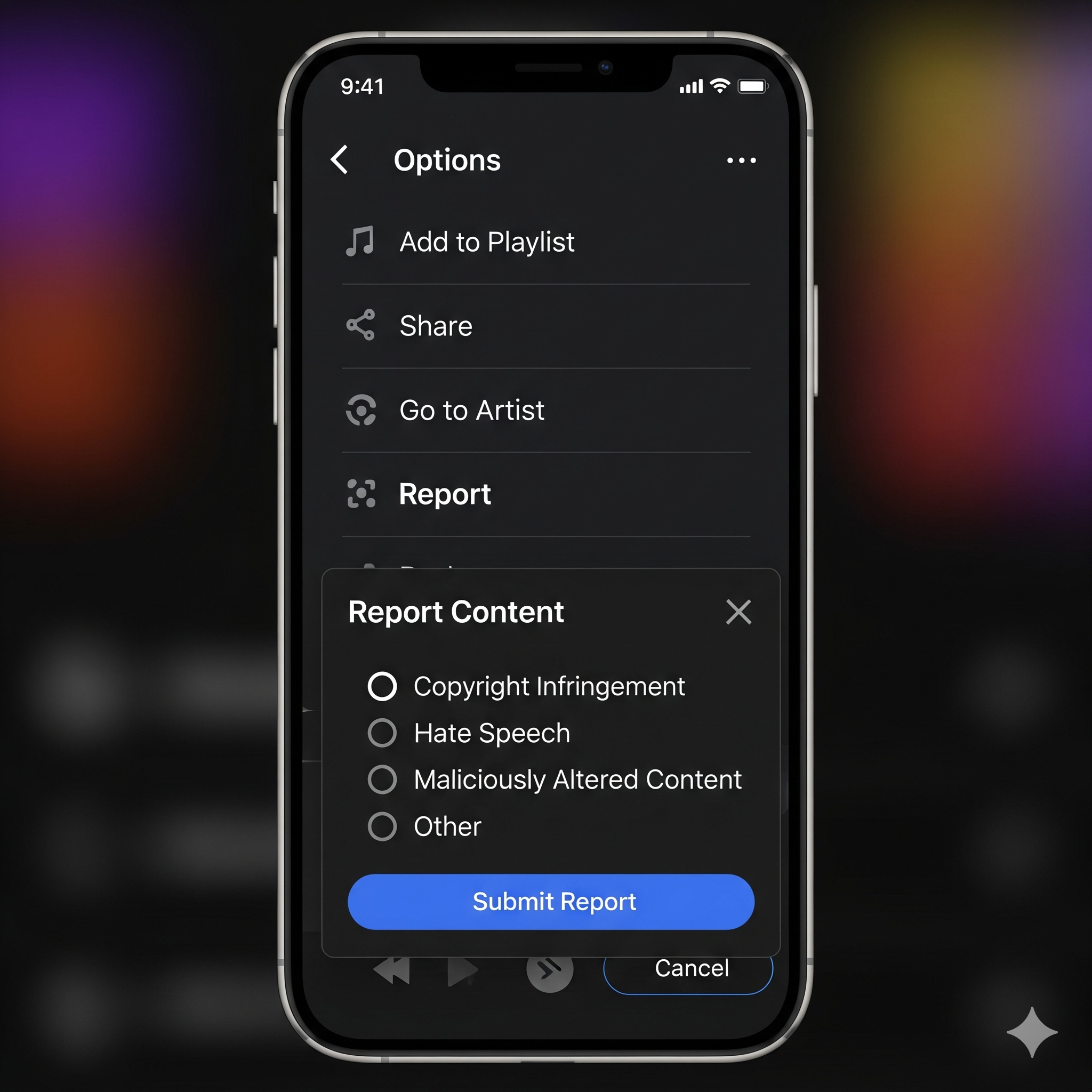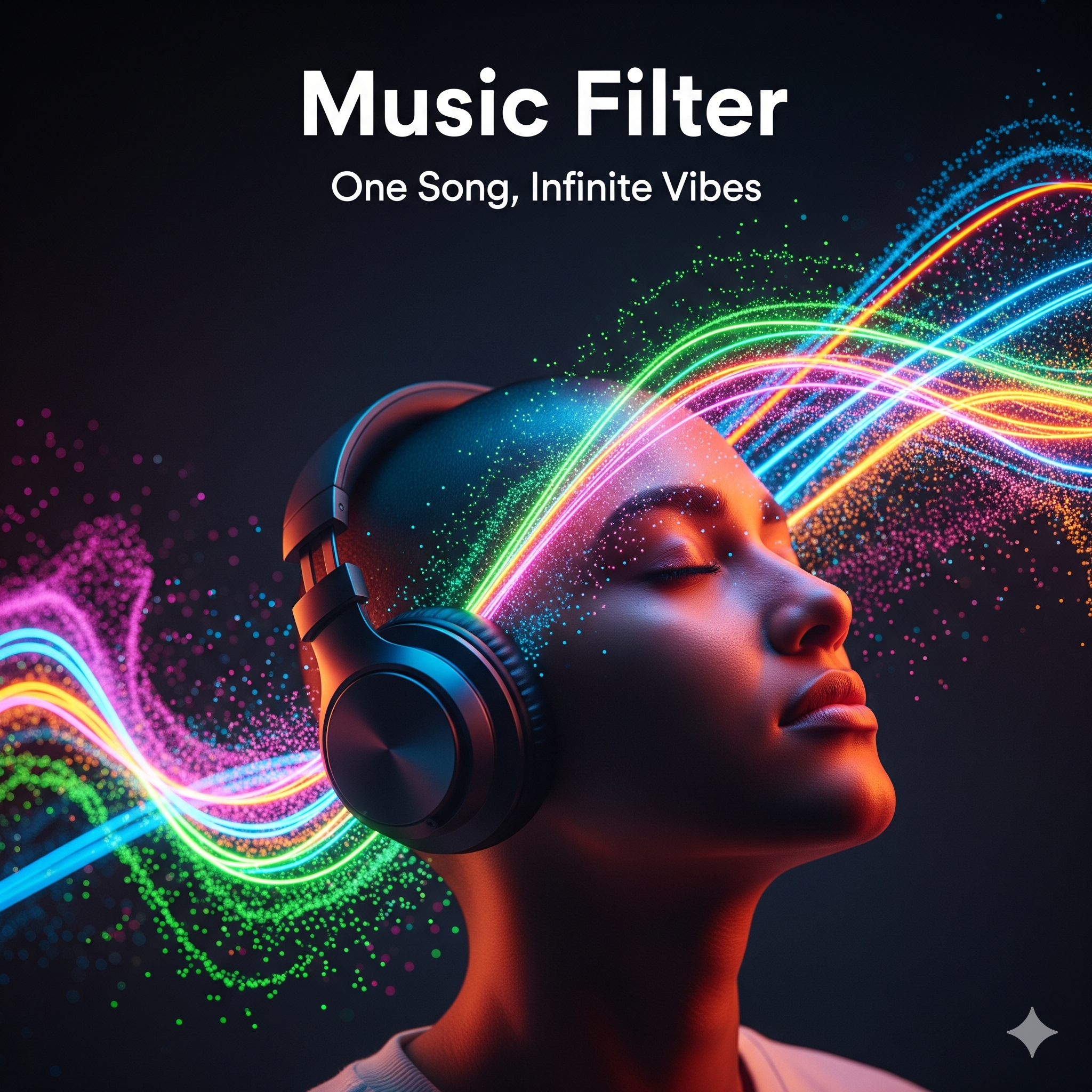Spotify: Infinite Music Filter
Concept Design – Mockup
One Song, Infinite Moods.
Your mood has a filter. Now your music does too.
With Spotify’s Music Filter, any song can instantly match how you feel. Turn a party anthem into a quiet acoustic tune, or a punk track into a gentle Lo-Fi hum. It’s not about finding the perfect remix anymore — it’s about creating your own sound.
The Origin of the Project
It started with something small: I realized I liked a “slowed” version of a song more than the original. Then I noticed I wasn’t alone — millions of listeners around the world were replaying unofficial remixes, AI edits, and mood versions again and again.
We weren’t looking for new songs. We were looking for new feelings within songs we already loved. The idea clicked one afternoon while I was editing a photo. If a single filter can change a photo’s entire mood — why isn’t it that easy to do the same with music? Instead of searching for the right remix on YouTube, what if I could simply tap a filter and feel the same song differently? That’s where the Music Filter began — as a bridge between creation and emotion.
Filters for Photos, Filters for Music
Problem
Music apps today are built for efficiency, not emotion. They can recommend what to play, but not how you want it to feel. We might want an acoustic version for the morning, or a high-energy remix for the gym — but unless someone else made that version, it doesn’t exist. There’s no simple, personal way to reshape a song to match the moment.
Insight
Just as photo filters helped everyone express their own aesthetic, music filters could help everyone express their own rhythm. It’s not about professional remixing — it’s about emotional tuning. By making “music filtering” as easy and intuitive as “photo editing,” Spotify could turn listeners into quiet creators — people who don’t just play music, but participate in it.
Solution: Spotify Music Filter
The Music Filter is a simple feature that lets anyone instantly remix a song to fit their mood, using AI. It’s an evolution of Spotify’s creative ecosystem — moving from passive listening to personal creation.
🎚 Pre-set Filters
Just one tap changes everything.
Tempo Filter: Slow it down or speed it up — the classic TikTok “slowed + reverb” made effortless.
Genre Filter: Turn a pop hit into a mellow acoustic track, or a punk anthem into a dreamy Lo-Fi beat.
Era Filter: Travel through time — 80s synthwave, 90s grunge, or 2000s pop sparkle.
Culture Filter: Explore cross-cultural sounds — Latin groove, K-pop style, J-pop rhythm.
Venue Filter: Feel the room — concert hall, jazz bar, or stadium reverb.
Scene Filter: Match your moment — workout, study, or sleep.
Instrument Filter: Swap sounds — piano becomes electric guitar, strings become synths.
🎨 Advanced Filters (For True Creators)
For those who want deeper control, Interactive Filters let users fine-tune genre, era, or emotion through intuitive sliders.
Example:
Listening to Coldplay’s A Sky Full of Stars → set +20 Acoustic, +50s Vintage, +10 Piano = a 1950s jazz-bar version.
The Collaboration Filter takes it further — AI can emulate an artist’s style, not their voice:
“Add Ariana Grande-style harmonies” or “make this sound like a BTS bridge.”
It’s co-creation, not cloning.
Legal & Ethical Design
Managing creative rights in an AI-driven feature isn’t just about legality — it’s about respect. Music Filter reimagines how technology, artists, and listeners coexist, guided by four core principles that protect creativity and keep collaboration human.
1. A Fair Revenue Sharing Model 🎵
This system starts with one belief — artists come first.
Original Creators: The songwriter, composer, and performer always retain full creative credit.
Spotify: Recognized for the filtering and arrangement technology that powers transformation.
Revenue Distribution: Most of the revenue (around 95%) from AI-filtered versions goes directly to the original creators, with Spotify taking only a minimal operational fee. This model ensures that creativity and compensation stay aligned, offering real incentive for artists and labels to participate.
But the benefit goes beyond profit. Each AI-filtered remix acts as organic word-of-mouth marketing — new versions spark curiosity on TikTok, Instagram Reels, and Shorts, bringing renewed attention to the original music itself.
2. No Vocal Cloning — Ever 🧠
Imitation isn’t creativity. That’s why Music Filter never replicates an artist’s actual voice or vocal fingerprint. Instead, it focuses on style, emotion, and atmosphere. You can ask the AI to add “Ariana Grande-style harmonies” or “a BTS-inspired bridge,” but the core voice — the artist’s identity — stays untouched.
This protects both the authenticity of the original work and the dignity of artistic expression. It also prevents the ethical and legal complications exposed by the “Heart on My Sleeve” incident. Listener creations are treated as acts of participation, not ownership — celebrated through community recognition and rewards, not copyright claims.
3. Transparent AI Version Management 🔍
Every filtered song carries its own digital fingerprint — unique, traceable, and safe.
Unique ID & Watermark: Each AI-filtered version is tagged (e.g., “Spotify AI Filter Ver.”) and stored with a unique ID in the metadata.
Limited External Sharing: These versions can only be shared or played inside the Spotify ecosystem — avoiding unlicensed uploads to YouTube or TikTok.
Library Integration: Users can save their favorite filtered versions directly into their personal library, and the ID ensures others can replay that exact same mix.
This structure keeps AI creativity contained within an ethical, transparent space — one where art can evolve without losing its roots.
4. Community Safety & Creative Responsibility 🌱
A creative community thrives only when it’s kind and safe.
Clear Guidelines: Spotify will enforce strict standards against harmful, offensive, or exploitative content, with account suspension for violations.
Community Reporting: Every shared version includes a simple “Report” button, letting users flag inappropriate edits in seconds.
Accountability: Before publishing, users agree that they are fully responsible for any content they create or share — ensuring safety for both Spotify and its community.
This balance of freedom and responsibility keeps Music Filter an open, inspiring, and respectful space for everyone — creators, listeners, and artists alike.
🌍 Why It Matters
Innovation means nothing without integrity. By embedding fairness, transparency, and empathy into its core, Music Filter ensures that creativity doesn’t come at the cost of trust. It protects what’s human about music — the emotion, the individuality, the story — even as technology amplifies it.
Impact
For Users
It gives everyone the ability to express emotion through sound — not just consume it. Music becomes alive again, changing with your mood, time, and place.
For Artists
Each remix is an extension of their art, a living dialogue with their audience. The more people filter, the more original music spreads.
For Culture
Music Filter bridges listening and creation — a new cultural medium where emotion becomes editable. It redefines music not as something finished, but as something that keeps growing with us.
🌍 The Future of Listening
The Music Filter turns Spotify into more than a music player — it becomes a creative space. Just as Instagram made photography universal, Spotify can make remixing universal. Because music isn’t static — it’s alive, breathing, and changing — just like the people who listen to it.
—
Speculative UX Concept by Jin Kim
Visual mockups generated with Gemini & ChatGPT (for concept purposes only)
